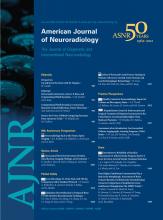Abstract
SUMMARY: Although radiography of the spine began shortly after Roentgen's discovery in 1895, there was little written in the medical literature about spine imaging until nearly 25 years later with the development of myelography, first by using air and then a variety of positive contrast agents. The history of spine imaging before CT and MR imaging is, in large part, a history of the development of contrast agents for intrathecal use. The advent of CT and, more important, MR imaging revolutionized spine imaging. The spinal cord and its surrounding structures could now be noninvasively visualized in great detail. In situations in which myelography is still necessary, advances in contrast agents have made the procedure less painful with fewer side effects. In this historical review, we will trace the evolution of spine imaging that has led to less invasive techniques for the evaluation of the spine and its contents and has resulted in more rapid, more specific diagnosis, therapy, and improved outcomes.
ABBREVIATION:
- LP
- lumbar puncture
- © 2012 by American Journal of Neuroradiology
Indicates open access to non-subscribers at www.ajnr.org







